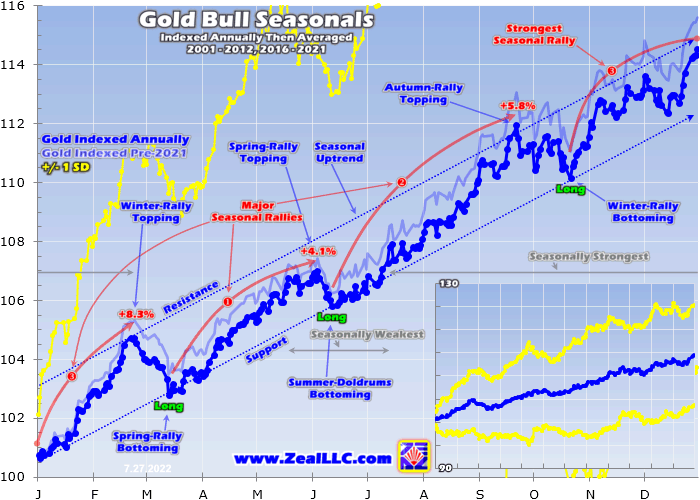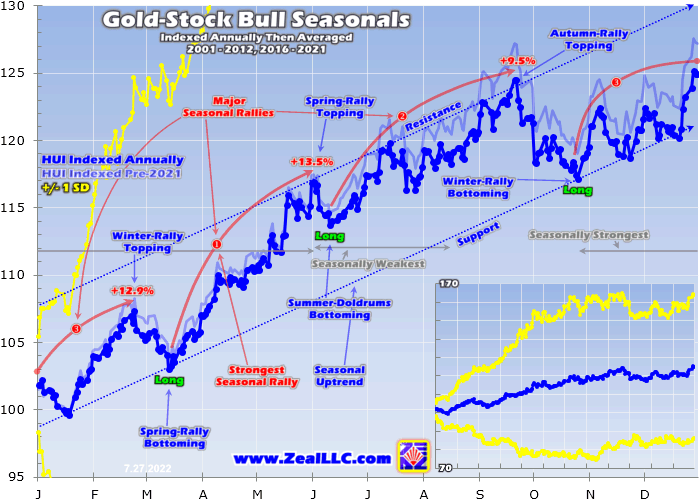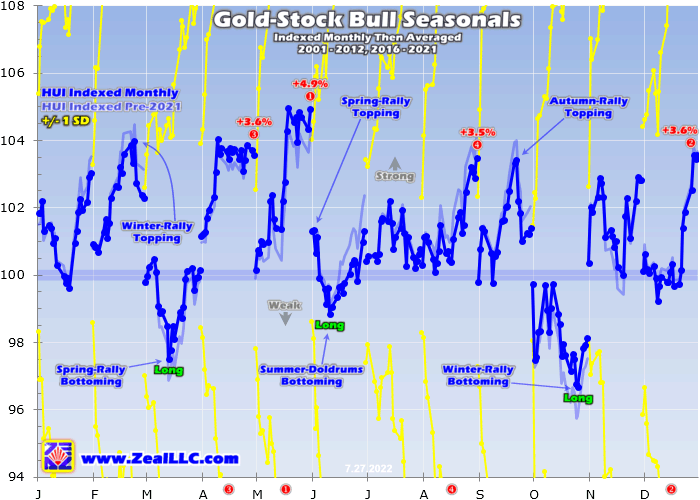The gold miners’ stocks have been thrashed in recent months, crushed as heavy futures selling slammed gold. That obliterated any residual sector bullishness, leaving gold stocks wildly-oversold and deeply-out-of-favor. But having weathered a rough early summer, the battered miners and their metal are trudging back into their traditional strong season. That begins with robust autumn rallies really accelerating in August.
Seasonality is the tendency for prices to exhibit recurring patterns at certain times during the calendar year. While seasonality doesn’t drive price action, it quantifies annually-repeating behavior driven by sentiment, technicals, and fundamentals. We humans are creatures of habit and herd, which naturally colors our trading decisions. The calendar year’s passage affects the timing and intensity of buying and selling.
Gold stocks display strong seasonality because their price action amplifies that of their dominant primary driver, gold. Gold’s seasonality generally isn’t driven by supply fluctuations like grown commodities see, as its mined supply remains relatively-steady year-round. Instead gold’s major seasonality is demand-driven, with global investment demand varying considerably depending on the time in the calendar year.
This gold seasonality is fueled by well-known income-cycle and cultural drivers of outsized gold demand from around the world. Starting in late summers, Asian farmers begin to reap their harvests. As they figure out how much surplus income was generated from all their hard work during the growing season, they wisely plow some of their savings into gold. Asian harvest is followed by India’s famous wedding season.
Indians believe getting married during their autumn festivals is auspicious, increasing the likelihood of long, successful, happy, and even lucky marriages. And Indian parents outfit their brides with beautiful and intricate 22-karat gold jewelry, which they buy in vast quantities. That’s not only for adornment on their wedding days, but these dowries secure brides’ financial independence within their husbands’ families.
Top Australian Brokers
- Pepperstone - Trading education - Read our review
- IC Markets - Experienced and highly regulated - Read our review
- eToro - Social and copy trading platform - Read our review
So during its bull-market years, gold has usually tended to enjoy major autumn rallies driven by these sequential episodes of outsized demand. Naturally the gold stocks follow gold higher, amplifying its gains due to their profits leverage to the gold price. Today gold stocks are once again back at their most-bullish seasonal juncture, the transition between the typically-drifting summer doldrums and big autumn rallies.
Since it is gold’s own demand-driven seasonality that fuels gold stocks’ seasonality, that’s logically the best place to start to understand what’s likely coming. Price action is very different between bull and bear years, and gold remains in a middle-aged bull market. After falling to a 6.1-year secular low in mid-December 2015 as the Fed kicked off its last rate-hike cycle, gold powered 29.9% higher over the next 6.7 months.
Crossing the +20% threshold in March 2016 confirmed a new bull market was underway. Gold corrected after that sharp initial upleg, but normal healthy selling was greatly exacerbated after Trump’s surprise election win. Investors fled gold to chase the taxphoria stock-market surge. Gold’s correction cascaded to serious proportions, hitting -17.3% in mid-December 2016. But that remained shy of a new bear’s -20%.
Gold rebounded sharply from those severe-correction lows, nearly fully recovering by early September 2017. But it failed to break out to new bull-market highs, then and several times after. That left gold’s bull increasingly doubted, until June 2019. Then gold surged to a major decisive breakout confirming its bull remained alive and well! Its total gains grew to 96.2% over 4.6 years by early August 2020, still modest.
Gold’s last mighty bull market ran from April 2001 to August 2011, where it soared 638.2% higher! And while gold consolidated high in 2012, that was technically a bull year too since gold only slid 18.8% at worst from its bull-market peak. Gold didn’t enter formal bear-market territory until April 2013, thanks to the crazy stock-market levitation driven by extreme distortions from the Fed’s QE3 bond monetizations.
So the bull-market years for gold in modern history ran from 2001 to 2012, skipped the intervening bear-market years of 2013 to 2015, then resumed in 2016 to 2022. Thus these are the years most relevant to understanding gold’s typical seasonal performance throughout the calendar year. We’re interested in bull-market seasonality, because gold remains in its latest bull today and bear-market action is quite dissimilar.
Prevailing gold prices varied radically through these modern bull years, running between $257 when gold’s last secular bull was born to August 2020’s latest record high of $2,062. All those long years with that vast range of gold levels have to first be rendered in like-percentage terms in order to make them perfectly-comparable. Only then can they be averaged together to distill out gold’s bull-market seasonality.
That’s accomplished by individually indexing each calendar year’s gold price action to its final close of the preceding year, which is recast at 100. Then all gold price action of the following year is calculated off that common indexed baseline, normalizing all years regardless of price levels. So gold trading at an indexed level of 110 simply means it has rallied 10% from the prior year’s close, while 95 shows it is down 5%.
This chart averages the individually-indexed full-year gold performances in those bull-market years from 2001 to 2012 and 2016 to 2021. 2022 isn’t included yet since it remains a work-in-progress. This bull-market-seasonality methodology reveals that late summers are when gold’s long parade of big seasonal rallies really gets underway. That starts with the major autumn rally which is born in gold’s summer doldrums.
Unfortunately several months ago in mid-April, gold started seriously diverging from seasonal norms. Fed officials panicked over the raging inflation unleashed by their own colossal QE4 money printing. So they embarked on the most-extreme hawkish pivot in this central bank’s entire century-plus history! A violent big-and-fast rate-hike cycle was launched, quickly followed by starting to reverse QE4 through QT2 bond selling.
All that actual and threatened Fed tightening catapulted the US dollar parabolic in an extreme rally. That scared gold-futures speculators into aggressively dumping longs while ramping up shorts. The resulting falling gold prices undermined investors’ bullishness, so they joined in the selling. That culminated in gold plunging 14.3% at worst into mid-July! That left it languishing down 7.3% year-to-date, huge underperformance.
Gold does tend to carve a major seasonal bottom in the summer doldrums, which births its subsequent autumn rally. But seasonally during these modern-bull-market years, that has tended to arrive earlier in mid-June. And gold fared much better on average, up 5.8% YTD at its summer lull. So the yellow metal is seriously behind its seasonal-performance precedent this year due to that super-anomalous US-dollar mania.
But despite gold’s bearish deviation in recent months, seasonals still turn strongly-bullish in late summers. That strength is mostly driven by big marginal demand returning for Asian post-harvest buying followed by that Indian wedding season. On average in these modern gold-bull years from 2001 to 2012 and 2016 to 2021, gold powered 5.8% higher between mid-June to late September! That makes for a strong autumn rally.
Those seasonal gains rank ahead of the spring rally’s 4.1% average but behind the winter rally’s hefty 8.2%. The autumn rally gathers steam as summers mature, with June, July, and August seeing average gains of 0.1%, 1.1%, and 2.0% during these bull years. That makes this seasonal strength well worth chasing. A typical 5.8% autumn rally off of mid-July’s deeply-oversold lows would still carry gold back up near $1,794.
But because it was bludgeoned so low by heavy gold-futures selling, gold’s autumn-rally upside potential this year is far greater than usual. On average in late September, this big seasonal surge has peaked with gold up 11.9% YTD. Merely mean reverting back up to those seasonal norms would necessitate a big 20.8% upleg to $2,047! Outsized autumn-rally gains following excessive selloffs actually aren’t unusual.
That last happened only a couple years ago in late-summer 2020, after gold was sucked into that year’s pandemic-lockdown stock panic. Between its summer-doldrums low in early June to mid-September, gold blasted 16.3% higher! Much of those strong gains were fueled by momentum buying as investors chased gold’s upside. After tumbling into mid-July this summer, gold is sure set up for bigger seasonal gains.
Interestingly the autumn rally’s usual gold demand from Asia should prove outsized this year. After each quarter, the World Gold Council releases excellent Gold Demands Trends reports detailing global gold supply and demand. The latest-available as I write this essay covered Q1’22. Both Chinese and Indian consumer gold demand shrunk sharply in this year’s opening quarter, plunging 18.8% and 18.3% year-over-year!
Beijing’s controversial COVID-Zero policy slammed Chinese gold demand in both Q1 and Q2. The WGC wrote back in late April, “As strict lockdowns were imposed in March across key cities such as Shanghai and Shenzhen, demand all but halted.” Back then the WGC warned, “The usual seasonal Q2 decline is likely to be exaggerated by the negative impact on jewellery demand of continued lockdown restrictions…”
When Chinese consumers are imprisoned in their apartments to slow COVID-19’s spread, they aren’t out buying gold jewelry like usual. Beijing finally starting easing its Draconian restrictions through June, but there have been some local lockdowns since. Gold should see big rebound demand as normal life resumes. In Q2’20 after China’s preceding lockdown quarter, its consumer gold demand soared 28.7% sequentially!
Indians weren’t paranoid about COVID-19, but these shrewd gold buyers shied away with surging gold prices. In Q1’22 gold averaged a lofty $1,879 in US-dollar terms. And from early January to early March gold blasted 14.7% higher, cresting weeks after Russia invaded Ukraine. That left Indians less interested in gold, since they never want to buy high. Their gold demand should also rebound with much-weaker prices.
Between mid-April to the end of June, US-dollar gold plunged 8.6%. And quarter-to-date in this young Q3 as of mid-July, gold had dropped another 6.1%. So Indian consumer gold demand is also likely to see a strong recovery in this autumn-rally timeframe. Last year’s third quarter saw Indians dramatically ramp up their gold-jewelry buying by 40.4% quarter-on-quarter! Something similar this year would really boost gold.
But the biggest probable driver of an outsized gold autumn rally in the next couple months is a sharp US-dollar selloff. Between mid-April to mid-July, the benchmark US Dollar Index skyrocketed up 8.8% in that extreme parabolic surge! That violent lurch higher on epic Fed tightening catapulted the USDX to a stunning 20.1-year secular high! The US dollar was extraordinarily-overbought, at unsustainable extremes.
Gold-futures speculators aggressively dumped longs and added shorts while the world’s reserve currency screamed higher, clubbing gold like a baby seal 13.5% lower in that same span! All that heavy selling exhausted these traders’ capital firepower, leaving them positioned for massive mean-reversion buying as that wildly-overcrowded euphoric long-dollar trade inevitably reverses. That will catapult gold sharply-higher.
As gold surges in a symmetrical recovery first on gold-futures short covering then later on momentum-chasing gold-futures long buying, investors will start moving capital back in to ride those gains. And a weaker US dollar should also boost traditional Asian gold demand during this autumn rally. Since global gold is mostly priced in US dollars then translated into local currencies, Chinese and Indian prices act differently.
If the Chinese yuan and Indian rupee rebound inversely-proportionally to the USDX’s fall, local gold prices could remain flattish despite dollar-gold surging. However it plays out, yuan- and rupee-gold prices should lag dollar-gold’s surge. And once dollar-gold mean reverts higher building decisive momentum, American investors will amplify gold’s autumn rally as Fed-money-printing-unleashed red-hot inflation rages.
That recent anomalous parabolic dollar surge temporarily disconnected gold from its millennia-old role as the ultimate inflation hedge. But as the dollar and gold mean-revert out of their recent extremes, gold will be remembered. With even lowballed headline CPI inflation running 9.1% YoY now, this is the biggest inflation super-spike since the 1970s! Gold’s performances during the last couple in that decade were epic.
In monthly-average-price terms from trough-to-peak CPI months, gold nearly tripled during the 1970s’ first inflation super-spike before more than quadrupling through the second! As investors see today’s newest inflation super-spike devour their disposable incomes and ravage stock markets, they will remember gold and reallocate larger chunks of their portfolios into it. Gold’s autumn-rally setup this year is exceptionally-bullish!
This next chart applies this same modern-gold-bull-year seasonality methodology to gold stocks. Since GDX was born later in May 2006, its price history is insufficient for longer-term studies. Thus the classic HUI gold-stock index is used instead. GDX and the HUI closely track each other, they are functionally-interchangeable containing most of the same large gold stocks. Gold’s gains fuel their own autumn rally.
On average during these same modern-gold-bull years of 2001 to 2012 and 2016 to 2021, gold stocks’ autumn rally witnessed 9.5% gains between mid-June to late September. While solid, that’s relatively-weak compared to gold’s 5.8% autumn rally. That only makes for 1.6x upside leverage, compared to GDX normally amplifying material gold moves by 2x to 3x. Gold stocks’ autumn rally took a big hit last year.
The light-blue lines in these charts show seasonals before 2021 was added in. Prior to that gold stocks had averaged much-better autumn-rally seasonal performance of 11.2%. Last year Fed hawkishness mounted during this late-summer timeframe, igniting big US-dollar buying and thus gold-futures selling. First Fed officials started predicting rate hikes, then began discussing slowing their extreme QE4 money printing.
So gold and gold stocks plunged sharply into late September, greatly dragging down seasonal averages. But those counter-seasonal lows birthed new uplegs in both gold and GDX, which powered 18.9% and 41.4% higher over the next 5.3 and 6.6 months! So 2021’s autumn selloff skewing seasonals lower was an anomaly spawned by heavy gold-futures selling as the USDX surged on Fed hawkishness, like recent months.
Seasonality merely reveals tendencies over long spans. Sentiment, technicals, and fundamentals remain the primary drivers of gold and its miners’ stocks. While seasonals reflect how these average out across calendar years, primaries can easily override seasonals in any given year. Think of these primary drivers like engines in airplanes, with seasonals like tailwinds or headwinds that accelerate or retard their paths.
Because gold has outsized autumn-rally potential this year, so do the deeply-oversold gold stocks. At GDX’s normal summer-doldrums low in mid-June, the major gold stocks average 13.7% YTD gains. But at its brutal recent low in late July, GDX was down a dreadful 23.2% YTD! That makes room for huge mean-reversion buying as gold recovers. That could catapult gold stocks back to normal autumn-rally levels.
Even after last year’s anomalous selloff dragged down gold-stock seasonals, GDX still averaged being up 24.5% YTD in late September. Just to regain those normal levels, it would have to rocket 62.2% out of late July’s lows to $39.88! While such a big run in such a short period of time probably won’t happen, it gives an idea of how deeply-oversold the gold stocks are. Even half that would make for a great autumn rally!
Like gold, gold-stock seasonals improve later in summers. On average in these modern-gold-bull years, the HUI or GDX climbed 1.3% in June, slumped back to a 0.8% gain in July, then really accelerated to big 3.5% gains in August! That final month of summer has actually proven the fourth best of the year for the major gold stocks. And this August could prove a blockbuster if these dollar and gold reversals accelerate.
This last chart slices gold-stock seasonals into calendar months, using a similar methodology. Each is indexed to 100 at the previous month’s final close, then all like-months’ indexes are averaged together. These same modern-gold-bull years of 2001 to 2012 and 2016 to 2021 are included. Between now and late September is an important time to be fully-deployed in gold stocks to ride their usual autumn rally!
While gold’s autumn rally gathers steam in July, the gold stocks lag. Vacation season has to be a factor, with fewer traders paying close attention to the markets. But gold stocks are ultimately leveraged plays on the metal they mine. So even outside of lazy summers, gold stocks only attract capital after gold has rallied long-enough and high-enough to start convincing traders it has decisive sustainable momentum.
Thus gold stocks tend to enjoy strong catch-up gains in August as their metal’s autumn rally solidifies. The more gold and its miners rally, the more speculators and investors rush to buy to chase those gains. Another factor boosting this sector in late summers is Q2 earnings season, which runs from late July to mid-August. The gold miners often report big sequential production growth and lower costs in second quarters.
Better fundamental results combined with rallying gold prices and traders’ kids going back to school have often proven a potent driver for big gold-stock gains. And again this year’s setup for gold is exceptionally-bullish. Huge gold-futures mean-reversion buying is coming as the radically-overbought US Dollar Index turns sharply-lower. The faster gold surges, the more capital will pour into gold stocks driving them higher.
While the major gold stocks of the HUI and GDX will amplify gold’s coming autumn-rally gains by 2x to 3x like usual, smaller fundamentally-superior mid-tier and junior gold miners will way-outperform. They are more able to consistently grow their outputs, which lowers costs, boosts profitability, and generates more cashflows for expansion. These smaller gold miners are in the sweet spot for upside potential as gold runs.
If you regularly enjoy my essays, please support our hard work! For decades we’ve published popular weekly and monthly newsletters focused on contrarian speculation and investment. These essays wouldn’t exist without that revenue. Our newsletters draw on my vast experience, knowledge, wisdom, and ongoing research to explain what’s going on in the markets, why, and how to trade them with specific stocks.
That holistic integrated contrarian approach has proven very successful. All 1,296 newsletter stock trades realized since 2001 averaged outstanding +20.0% annualized gains! While we suffered a mass-stopping during gold stocks’ latest plunge, we’re rebuilding our trading books with cheap fundamentally-superior mid-tier and junior gold and silver miners to ride their coming upside. Subscribe today and get smarter and richer!
The bottom line is gold and its miners’ stocks are reentering their strong season. That starts with nice autumn rallies mostly in August and September, normally fueled by Asian seasonal gold demand. That has excellent potential to prove larger than usual this year as China rebounds from more lockdowns. But much more important for gold this year is the recent anomalous parabolic US-dollar rally decisively rolling over.
That will reverse the heavy gold-futures selling that pounded gold lower as the dollar soared into massive buying. First gold-futures short-covering, then momentum-chasing long buying, and finally investors piling on will catapult gold and gold stocks sharply-higher. That could make for a heck of an autumn rally, mean reverting out of anomalous mid-summer lows during this super-gold-bullish first inflation super-spike since the 1970s.
Published by Adam Hamilton of Zeal LLC Specialising in stock-market speculation and investment from a contrarian perspective. This material has been prepared for general information purposes and must not be construed as investment advice.








